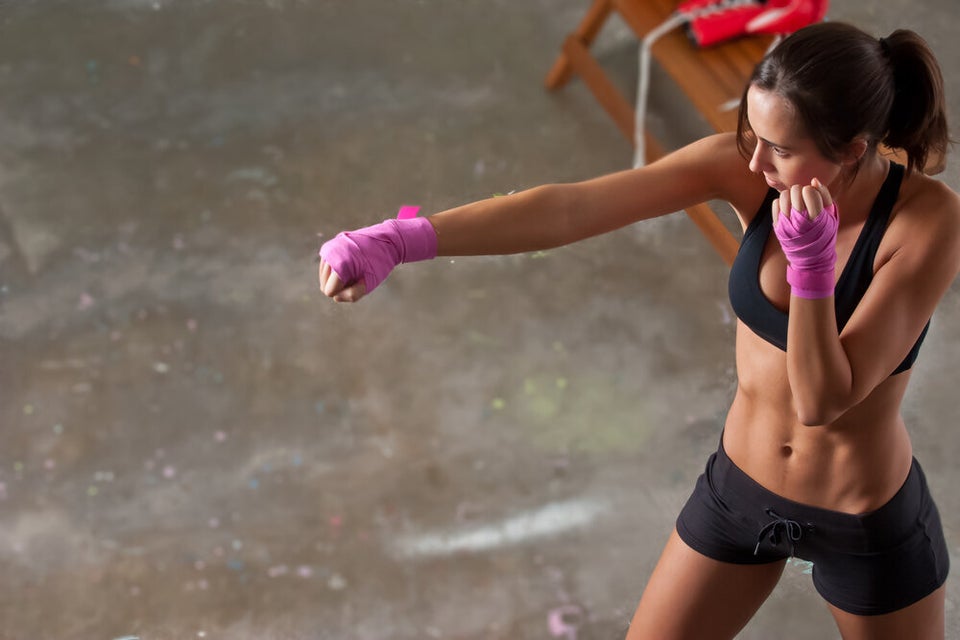
It's all fun and games — yes, even when we're breaking a sweat — until someone gets hurt.
If you're in the mindset that working out is supposed to be fun in 2013, painful muscles and joints are two things you can avoid by perfecting your form.
"It's not so much the exercises as it is overdoing them. We have the tendency to work out the muscles we think we can see, but it's the imbalances of all of our muscles that causes most of the pain," says Jordan Cieciwa, personal strength coach and trainer at One Fit City, based in Winnipeg, Man.
It's one thing to feel pain in your legs and arms the day after a 30-minute bootcamp class, but it's another to constantly feel like your muscles and joints are getting weaker. Cieciwa says people often can't distinguish between soreness and injury.
"I walk my clients through a self-assessment and have them perform a range of motions so we can identify if it's joint pain versus sore aching muscles," he tells The Huffington Post Canada.
Besides working out with an injury (which Cieciwa sees often), over-training is another cause of joint and back pain. Some symptoms of over-training syndrome include feeling washed out, a loss of appetite and for some, insomnia, according to health writer Elizabeth Quinn of About.com.
And some areas of pain are more common than others. Cieciwa says he often sees people with lower back pain, partly due to the fact that most of us sit during the day. One report found that constant sitting is slowly killing us, as our bodies were not designed to sit for a prolonged period of time.
To build stability in your core (the best way to prevent injuries) and to avoid that lower back pain, Cieciwa recommends stretching at your desk, getting up and walking around and sitting with your legs at a 90-degree angle with your back straight.
Here are 10 common exercises that could be hurting you. Remember, feeling sore from exercising is normal and even satisfying, but injuries will only set you back — so make sure you go at your own pace:
Punching:
You might think you're an action movie star as you throw out free punches, but getting too aggressive can actually injure your arm muscles. "Classes and at-home workouts that don't have you striking into a hand pad or against a target will cause aggravation to the joints," says Jordan Cieciwa, personal strength coach and trainer of One Fit City, based in Winnipeg, Man. Cieciwa says throwing a punch to no end can also cause injury to your rotator cuff — the muscles that stabilize your shoulders.
Kicking:
Similar to punching, kicking to no end can also cause knee injuries and joint pain. "Planting the foot and kicking puts a lot of torque on the knee. That force has to go somewhere, and that somewhere is through the ACL and PCL (both knee ligaments)," Cieciwa says. To avoid injuries, speak to a trainer on proper form and make sure you make contact with a target.
Kettlebell Swings:
Although swinging a kettlebell is an excellent exercise for your core, you can also hurt your back and spine with improper form. "To battle this, ensure you engage your core. Learn proper form — the swing isn't from hip extension as much as it is from the force produced from squatting and pushing with the legs," Cieciwa says. He also recommends always starting with a beginner kettlebell class or one-on-one with someone else as a precaution.
Kettlebell Snatch:
The kettlebell snatch is an exercise (popular among Olympic athletes) where you pull a kettlebell off the floor by extending your hips, knees and arms. "Stability (through your core) is key to ensure your shoulders are safe. The wrist needs to be supported by a strong forearm, that means selecting a weight that you can control," Cieciwa says. This exercise in particular, isn't for everyone. If you want to work out with a kettlebell, start off with kettlebell swings (previous slide) or holding it during a squat to get used to the weight.
Push-Ups:
It's an exercise most of us conquer (or at least try to) when we hit the gym. But Cieciwa says people often do too many push-ups and don't engage their core. "Most of the problems and mistakes we see during this exercise is due to lack of strength and inability to use your muscles. Think about it, it you haven't done a push-up in five, 10, or even 15 years, chances are your body has forgotten how," he says.
Pull-Ups:
Although it's rare to get injured from a pull-up, Cieciwa says adding a load on your spine by pulling up with your muscles or joints that are not controlled can lead to pain. "The more you train your muscles to control themselves, work together, and get stronger, the better your odds are of not letting this happen," he says.
Exercise Ball Chest Press:
Are you engaging your hips? Cieciwa says people tend to get lazy with their hips and let them drop as they work their arms. But these so-called "lazy hips" may also be hurting you in the long run. "It's a sign that people are sitting too much and we're not able to engage our glutes to keep ourselves steady," he says. Every time you do this exercise, make sure you squeeze your glutes, keep your hips up and have a flat front.
Bicep Curl:
Besides getting strain from lifting an incorrect weight amount, performing bicep curls with your chin forward can hurt your posture. Often our chin moves forward during bicep curls as a natural way for our bodies to ease the movement for our muscles. When you are performing this curl, keep your posture straight and keep your ears in line with your shoulders, Cieciwa says.
Squat/Lunge:
When gym-goers do squats and lunges, Cieciwa says we often forget how much we sit during the day. "If you spend your whole day seated, your chest and quad muscles will shorten. When you stand up, your newly shortened quads will pull on the weakest link in the chain (of muscles)," he says. If you have a weak core, your lower back often has a hard time making up for your shortened quads — which can lead to back pain. Again, to perform a proper lunge and squat, perfect your form and engage your core, glutes and posture.
Hamstring Curls:
Even if you add five to 10 hamstring curls to your workout, Cieciwa says most of the time, people don't do them enough. This exercise (extending and working the backside of your upper leg), helps our body control our muscles. However, people tend to lift their hips or work out other leg muscles that can leave a strain on the leg you're trying to strengthen. To avoid this, make sure your hamstring curls are focused on your upper leg — you can use a curl machine for more support. To start, try four to five sets of eight to nine curls or ask a trainer for sets based on your strength.
